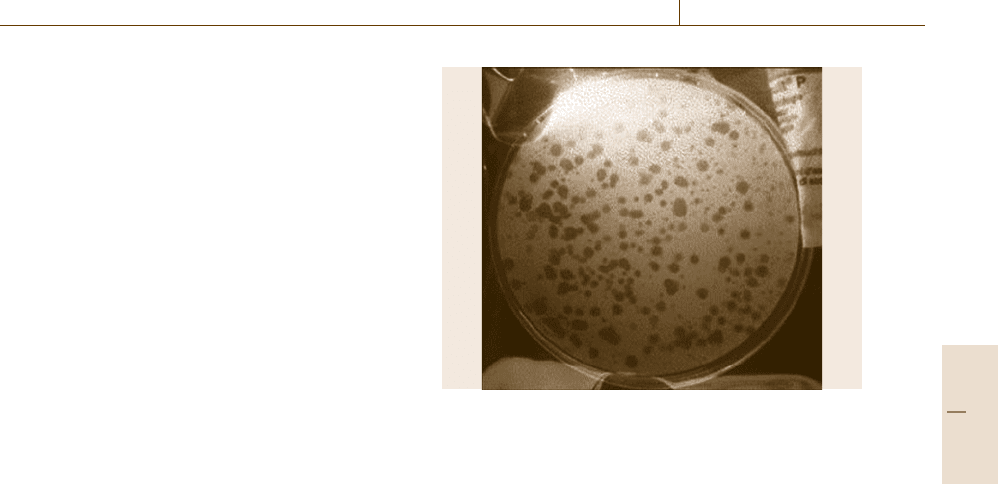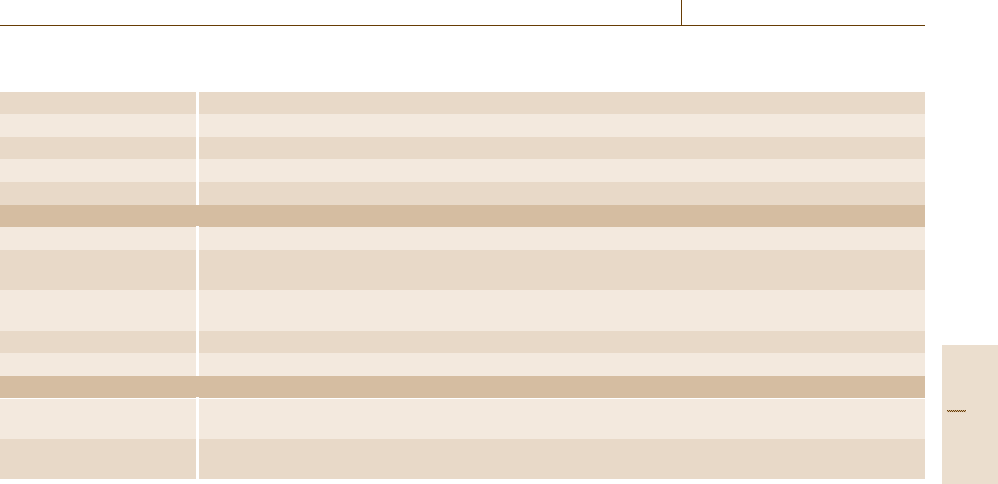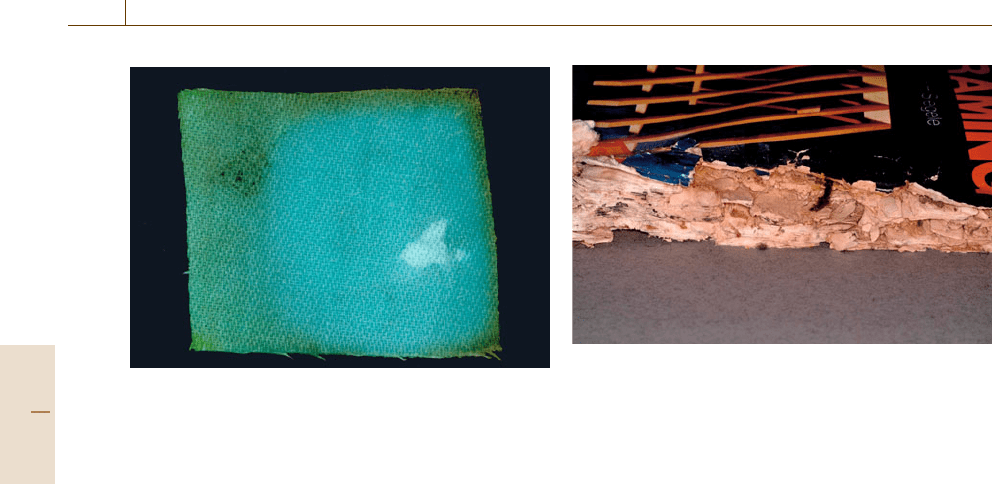Czichos H., Saito T., Smith L.E. (Eds.) Handbook of Metrology and Testing
Подождите немного. Документ загружается.


798 Part D Materials Performance Testing
with infrared detectors and paramagnetic O
2
-detectors
are often used for such experiments.
However, besides of the advantage of an automated
and continuous measurement, this kind of measure-
ments harbor also some disadvantages. The exact air
flow must be known and the signals of the detectors
must be stable for weeks and month. If slow degradation
processes have to be monitored, the CO
2
-concentration
or the drop in the O
2
-concentration is very low, in-
creasing the possibility of systematic errors during such
long-lasting experiments. Here, entrapping CO
2
in a ba-
sic solution (≈ pH 11.5) with continuous titration or
detection of the dissolved inorganic carbon [14.59] are
useful alternatives. Other attempts to solve the problems
with CO
2
detection use noncontinuously aerated, closed
systems. Sampling techniques of the gas in combina-
tion with an infrared gas-analyzer [14.60] or a titration
system [14.61] have been reported in the literature. An
additional closed system with a discontinuous titration
method has been described by Solaro et al. [14.62].
Tests using small closed bottles as degradation reac-
tors and analyzing the CO
2
in the head space [14.63]or
by the decrease in dissolved oxygen (so-called closed
bottle test) [14.64] are simple and quite insensitive to
leakage etc., but may cause problems due to the merely
low amounts of material and inoculum which can be
used.
The method of CO
2
-determination to monitor poly-
mer degradation was also adapted to tests in solid
matrices such as compost [14.38]. Such methods are
now standardized under the name controlled compost-
ing test (ASTM D 5338-98e1, ISO 14855, JIS K 6953).
Actually the controlled composting test does not sim-
ulate a composting process, since in this test mature
compost is used instead of fresh biowaste as a matrix.
Biowaste contains large amounts of easily degradable
carbon and, hence, would cause a high background
CO
2
-development, too high for an accurate meas-
urement. Thus, already converted biowaste (=mature
compost) is used instead of fresh biomaterials.
Monitoring polymer degradation in soil via carbon
dioxide detection turned out to be more complicated
than in compost. The usually significantly slower degra-
dation rates causing on the one side very long test
durations (up to two years) and a quite low CO
2
evo-
lution compared to the background CO
2
formation in
soil. Recent test developments in this area have been
published by Solaro et al. [14.62]. Despite of the prob-
lems mentioned above, standardized methods for testing
plastics degradation in soil are currently under develop-
ment (ISO/PRF 17556).
In order to avoid problems with a high background
CO
2
formation from the natural matrices of compost or
soil, an inert, carbon-free and porous matrix has been
used instead of soil or compost. The inert matrix is
then wetted with a synthetic medium and inoculated
with a mixed microbial population. This method turned
out to be practical for simulating compost conditions
(degradation at ≈ 60
◦
C) [14.65, 66] but could not be
optimized sufficiently for soil conditions up to now.
Measurement of Biogas. Analogous to the forma-
tion of CO
2
in the presence of oxygen by aerobic
organisms, anaerobic microorganisms produce predom-
inantly a mixture of carbon dioxide and methane
(called biogas) as the major end-product of their
metabolic reactions. The amount and the composition
of the biogas can be theoretically calculated from the
material composition with the so-called Buswell equa-
tion [14.67]. The biogas production is mainly used for
monitoring biodegradation of plastics under anaerobic
conditions [14.68–71] and also standards dealing with
the anaerobic biodegradation of plastics are based on
such measurements (ISO/DIS 15985, ASTM D 5210,
ASTM D 5511). The biogas volume can easily be deter-
mined by a manometer method or a simple replacement
of water. Additionally, the biogas composition can be
analyzed, e.g., by sampling the produced gas and anal-
ysis by gas chromatograhpy [14.72].
As discussed for the carbon dioxide evolution, the
basic problem is biogas formation from the inoculum.
Especially for slow degradation processes this problem
affects the accuracy of the testing method. Attempts to
reduce the background biogas evolution were made by
Abou-Zeid [14.68] diluting the anaerobic sludges with
a synthetic mineral medium.
14
C-labeling. Applying biodegradable polymers which
are radio-labelled with
14
C can avoid many of the prob-
lems mentioned above. Already very low concentrations
of
14
CO
2
can be detected even if carbon dioxide from
other carbon sources (e.g., biowaste) is produced simul-
taneously. Thus, radio-labelling is used especially when
slowly degradable materials are investigated in a matrix
containing other carbon sources than the plastics [14.73,
74]. However, in many cases there is a problem with
producing the
14
C-labelled materials and carrying out
work with radioactive substances from the experimental
point of view.
Clear-Zone Formation. The so-called Clear-Zone test
is a very simple semi-quantitative method. In this test
Part D 14.3

Biogenic Impact on Materials 14.3 Testing of Organic Materials 799
the polymer is dispersed as very fine particles in a syn-
thetic medium agar, resulting in a opaque appearance
of this agar. When inoculated with microorganisms able
to degrade the polymer the formation of a clear halo
around the colony (Fig. 14.11) indicates that the or-
ganisms are at least able to depolymerize the polymer,
which is the first step of biodegradation. The test is of-
ten used for screening of organisms which can degrade
a certain polymer [14.68, 75] but also semiquantitative
results can be obtained by analyzing the growth of the
clear zones’ diameters [14.76].
Other Methods. Some other analytical methods for
monitoring biodegradation processes, especially in
degradation experiments with depolymerizing enzymes
have been described in the literature.
•
Analysis of the amount of dissolved organic
carbon (DOC) in the medium around the plas-
tics [14.77].
•
Monitoring the decrease in optical density of small
polymer particles dispersed in water [14.78].
•
Analysis of decrease in particle size of small poly-
mer particles using light-scattering [14.49].
•
Determination of the free acids formed in en-
zymatic polyester cleavage applying a pH-stat-
titration [14.30,47,50].
Standards for Biodegradable Plastics
At the beginning of the nineties demands were stated
namely by the industry to establish suitable and re-
liable standardized testing procedures to evaluate the
biodegradability of plastics. Most of the new stan-
dards developed were based on existing tests for the
biodegradation of low-molecular-weight chemicals. An
overview of standard test methods for biodegradable
plastics is given in Table 14.5.
First standards, mainly focused on water- and
landfill environments, were published by the ASTM.
A test system to evaluate the compostability of
plastics was first developed by the German DIN
(DIN V 54900). This standard did not only specify
testing procedures, but defined also limit values for
the evaluation. Other international standards from ISO,
CEN and ASTM generally followed the testing strat-
egy given by DIN V 54900, which has meanwhile
been substituted by the according European standard
(EN 13432).
Currently, the development of standards is fo-
cussed on degradation in soil, since there is a great
interest for applications of biodegradable plastics in
Fig. 14.11 Clear-zone-test: Fine dispersed polymer (β-
hydroxybutyrate) in an microbiological agar plate results
in a turbid occurrence of the agar. Microorganisms grow-
ing on the agar form clear halos (zones) if they are able to
depolymerize the polymer
agriculture, e.g., as nonrecoverable mulching films
or as matrices for controlled release of nutrients or
pesticides etc. Compared to degradation in a com-
post environment, tests to evaluate degradation in
a soil environment proved to be much more complex
(e.g., due to different soils or wide variations in external
conditions).
In the following, standardization agencies are listed
which are involved in the development of standards for
biodegradable plastics.
International: ISO TC61/C5/WG22 Biodegradability
Europe: CEN TC 261/SC4/WG2 Biodegradabil-
ity and organic recovery of packaging
and packaging waste
CEN TC249/WG9 Characterization of
degradability
National:
France: AFNOR
Germany: DIN FNK 103.3 Bioabbaubare Kunst-
stoffe (This group has been liquidated
in 2002)
Italy: UNI
Japan: MITI/JIS
USA: ASTM D20.96 Environmentally degrad-
able plastics
A number of reviews dealing with standard testing
methods for biodegradable plastics have been published
during the last years [14.36,79–81]. For some particular
Part D 14.3

800 Part D Materials Performance Testing
Table 14.5 Standards related to biodegradable plastics
Biodegradability in different environments/simulation tests
ISO 14851 – 1999 Determination of the ultimate aerobic biodegradability of plastic materials in an aqueous medium –
Method by measuring the oxygen demand in a closed respirometer
ISO 14852 – 1999 Determination of the ultimate aerobic biodegradability of plastic materials in an aqueous medium –
Method by analysis of evolved carbon dioxide
ISO/DIS 14853 – 1999 Determination of the ultimate anaerobic biodegradability of plastic materials in an aqueous system –
Method by measurement of biogas production
ISO 14855 – 1999 Determination of the ultimate aerobic biodegradability and disintegration of plastic materials under controlled
composting conditions – Method by analysis of evolved carbon dioxide
ISO 14855/DAmd 1 Use of a mineral bed instead of mature compost
ISO/AWI 14855-2 Determination of the ultimate aerobic biodegradability and disintegration of plastic materials under controlled
composting conditions – Part 2: Gravimetric measurement of carbon dioxide evolved in a laboratory-scale
test
ISO/DIS 15985 – 1999 Plastics – Determination of the ultimate anaerobic biodegradability and disintegration under high-solids
anaerobic-digestion conditions – Method by analysis released biogas
ISO 17556 – 2003 Plastics – Determination of the ultimate aerobic biodegradability in soil by measuring the oxygen demand in
a respirometer or the amount of carbon dioxide evolved
CEN TC 249 WI 240509 Plastics – Evaluation of degradability in soil – Test scheme for final acceptance and specifications
ASTM D 5210-92(2000) Standard method for determining the anaerobic biodegradability of degradable plastics in the presence of
municipal sewage sludge
ASTM D 5271-02 Standard test method for assessing the aerobic biodegradation of plastic materials in an
activated-sludge-wastewater-treatment system
ASTM D 5338-98e1 Standard test method for determining the aerobic biodegradation of plastic materials under controlled
composting conditions
ASTM D 5511-94 Standard test method for determining anaerobic biodegradation of plastic material under
high solid anaerobic digestion conditions
ASTM D 5525-94a Standard practice for exposing plastics to a simulated landfill environment
ASTM D 5526-94(2002) Standard test method for determining anaerobic biodegradation of plastic materials under accelerated landfill
conditions
ASTM D 5988-96 Standard test method for determining aerobic biodegradation in soil of plastic materials or residual plastic
materials after composting
ASTM D 6340-98 Standard test methods for determining aerobic biodegradation of radio-labelled plastic materials in an aqueous
or compost environment
ASTM D 6691-01 Standard test method for determining aerobic biodegradation of plastic materials in the marine environment
by a defined microbial consortium
ASTM D 6692-01 Standard test method for determining the biodegradability of radiolabeled polymeric plastic materials in
seawater
ASTM D 6776-2002 Standard test method for determining anaerobic biodegradability of radiolabelled plastic materials in a
laboratory-scale simulated landfill environment
JIS K 6950 – 2000 Determination of ultimate aerobic biodegradability of plastic materials in an aqueous medium –
Method by measuring the oxygen demand in a closed respirometer
JIS K 6951 – 2000 Determination of the ultimate aerobic biodegradability of plastic materials in an aqueous medium –
Method by analysis of evolved carbon dioxide
JIS K 6953 – 2000 Determination of the ultimate aerobic biodegradability and disintegration of plastic materials under controlled
composting conditions – Method by analysis of evolved carbon dioxide liquidate
PR NF U 52-001PR Mat
´
eriaux de paillage biod
´
egradables pour l’agriculture – Exigences, m
´
ethodes d’essais et marquage
Compostability
ISO 16929 – 2002 Plastics – Determination of the degree of disintegration of plastic materials under defined composting
conditions in a pilot-scale test
ISO 20200 – 2004 Plastics – Determination of the degree of disintegration of plastic materials under simulated composting
conditions in a laboratory-scale test
EN 13432 – 2000 Packaging – Requirements for packaging recoverable through composting and biodegradation – Test scheme
and evaluation criteria for the final acceptance of packaging
Part D 14.3

Biogenic Impact on Materials 14.3 Testing of Organic Materials 801
Table 14.5 (continued)
ASTM D 5509-96 Standard practice for exposing plastics to a simulated compost environment
ASTM D 5512-96 Standard practice for exposing plastics to a simulated compost environment using an externally heated reactor
ASTM D 6002-96 Guide to access the compostability of environmentally degradable plastics
ASTM D 6400-99e1 Standard specification for compostable plastics
UNI 10785-1999 Compostilita del materiali plastici – Requisiti e metodi di prova
Polyethylene degradation and photodegradation
ASTM D 3826-98 Standard practice for determining end point in degradable polyethylene and polypropylene using a tensile test
ASTM D 5071-99 Standard practice for operating xenon arc-type exposure apparatus with water and exposure of photo
degradable plastics
ASTM D 5208-01 Standard practice for operating fluorescent ultraviolet and condensation apparatus for exposure of photo
degradable plastics
ASTM D 5272-99 Standard practice for outdoor exposure testing of photo degradable plastics
ASTM D 5510-94(2001) Standard practice for heat ageing of oxidatively degradable plastics
Other tests
ASTM D 5951-96(2002) Standard practice for preparing residual solids obtained after biodegradability methods for toxicity and
compost quality testing
ASTM D 6003-96 Standard test method for determining weight loss from plastic materials exposed to simulated municipal solid
waste (MSW) aerobic compost environment
environments standards for biodegradable plastics will
be discussed more in detail in the following.
Compostabilty of Plastics. The treatment of biodegrad-
able plastics in composting processes is discussed as
an alternative to plastics recycling or incineration.
A number of standards for the evaluation of the com-
postability of plastics have been published, which all
are, in major respects, congruent (ASTM D 6002-96/
ASTM D 6400 99e1, EN 13432 2000); an international
norm (ISO CD 15986) is currently under development.
Generally, demands for compostability exceed those for
biodegradability; compostability usually comprises four
demands [14.82].
•
The organic fraction of the material must be com-
pletely biodegradable;
•
The material must disintegrate sufficiently during
the composting process;
•
The composting process should not negatively be
affected by the addition of the plastics;
•
The compost quality should not be negatively influ-
enced and no toxic effects should occur.
Taking account of this spectrum of criteria and the
principle problems in testing biodegradability in com-
plex (natural) environments discussed above, all test
schemes follow for a successive, multistep evaluation
strategy.
1. Chemical characterization of the test material
These data serve for the identification of the mater-
ial, provide important data for the following tests
(e.g., carbon content, composition, content on inor-
ganic components etc.) and especially give informa-
tion on toxic substances such as heavy metals.
2. Evaluation of biodegradability
The biodegradability is evaluated by laboratory test-
ing methods monitoring the metabolization of the
material by CO
2
formation or O
2
consumption.
Two test methods use synthetic aqueous media (ISO
14851, ISO 14852) and allow to establish a car-
bon balance (besides carbon dioxide, newly built
biomass is regarded as degraded carbon). The pre-
ferred testing method, however, is the so-called con-
trolled composting test [14.38, 41, 42, 83, 84] with
mature compost at a temperature of around 60
◦
C
as matrix. The relevance of aquatic tests in a test
scheme pertaining to a compost environment has
been discussed critically [14.85]. However, disad-
vantages of the controlled composting test are the
relatively high background CO
2
formation, which
can be affected by the presence of plastics (prim-
ing effect) and difficulties in determining a carbon
balance with sufficient accuracy. To overcome these
problems, the biodegradation is calculated relative to
the CO
2
-release of a degradable reference substance
(e.g. cellulose) or an inert solid matrix inoculated
with an eluate from compost is used instead of ma-
ture compost [14.65,66].
In the test schemes, also limit values are given for
the evaluation[14.86]. The maximum test duration is
usually 6 month (1 year for radio-labelled materials
Part D 14.3

802 Part D Materials Performance Testing
in ASTM D6400) and the degrees of degradation re-
quested are 60% and 90% relative to the reference.
The value of 60% CO
2
formation originates from
the OECD guidelines which were developed for low-
molecular, chemically homogeneous materials. The
figure takes into account that a part of the carbon is
convertedto biomass. Plastics, however, are complex
in their composition (blends, copolymers, additives)
and, thus, the limit value of 90% had been set to en-
sure a complete degradability of the entire material
(a 10% error range was assumed for the degradation
tests). In aqueous media this limit usually can only be
achieved including the biomass formed (carbon bal-
ance). In mature compost less new biomass is formed
and CO
2
levels of more than 90% are observed for
many polymers.
3. Characterization of disintegration in compost
Since in real biowaste respirometric measurements
are not possible with a sufficient accuracy, in a real
compost environment only disintegration of the ma-
terials is evaluated. Disintegration testing can be
performed in laboratory tests using controlled reac-
tors of some hundred liters content [14.87] or tests in
a real composting plant. The degree of disintegration
is determined by sieving the compost and analyzing
polymer fragments larger than 2 mm (in all standards
a maximum fraction of 10% is allowed).
4. Compost quality/toxicity
The quality of the final compost should not nega-
tively be affected when plastics are composted. Tests
to evaluate this requirement are defined by estab-
lished national testing methods ensuring compost
quality. Criteria for compost quality are, for instance,
maturity, visual impurities, density, pH, content of
nutrients, salts, heavy metals etc. Additionally, eco-
toxicity tests focused on plant growth are part of the
compost quality characterization (e.g., plant tests ac-
cording to OECD guidelines (OECD 208)).
Additional toxicity tests (e.g., tests with earthworm,
luminicent bacteria, Daphnia magna, fish) were dis-
cussed during the development of the standards
[14.41, 57, 88, 89], but due to the limited expe-
riences with these tests in combination with com-
post, these tests were not generally included in
the test schemes for compostability (ASTM in-
cludes earth worm test according to OECD guideline
OECD 207).
Anaerobic Biodegradability. Beside normal compost-
ing, the treatment of biowaste by anaerobic digestion
(anaerobic composting) is becoming more and more
widespread. It has been demonstrated that the anaerobic
biodegradation behavior of plastics can differ signifi-
cantly from that under aerobic conditions [14.68, 69].
Thus, separate tests must become established in or-
der to also include these conditions for biodegradation
of plastics. Some standard methods for monitoring
the anaerobic degradation via biogas formation do al-
ready exist (ASTM D 5511-94, ISO/DIS 14853 1999,
ISO/DIS 15985 1999), based on testing protocols de-
signed for low-molecular substances [14.90]. However,
the evaluation schemes for biodegradable plastics do
not mandatorily demand the proof of anaerobic degrad-
ability up to now (in EN 13432 anaerobic tests are
mentioned, but are optional).
Biodegradation in Soil Environment. After focus-
ing on degradation in landfills and then on composting
processes at the first stage of standardization efforts,
currently the characterization of the evaluation of plas-
tics biodegradation in soils has become important since
there is now a growing interest in applications of
biodegradable plastics in agriculture (e.g., as mulching
films or as matrix for controlled release of fertilizers and
pesticides).
Compared to the evaluation of the compostabil-
ity, standardization of testing methods focused on soil
degradation face some serious problems.
•
Composting is a technical process where parameters
such as pH, temperature, humidity and biowaste
composition are kept in certain limits to guarantee
an optimal composting process. In soil, the kind of
environment and the environmental conditions can
vary significantly and usually can not be controlled
in nature. Standards have to take these variations
into account somehow.
•
The higher temperatures and activity of the microor-
ganisms involved, causes biodegradation of plastics
during composting to usually be faster than in a nat-
ural soil environment.
It is much more difficult to monitor the slow
degradation processes of some plastics in soil with
a sufficient accuracy. Slow degradation sometimes
causes extremely long test periods (>1y).
Currently the CEN working group CEN TC249/
WG9 Characterization of degradability is developing
an evaluation scheme for soil degradation of plastics.
The structure of this scheme very likely will be gen-
erally similar to that for composting including the
different aspects mentioned above. However, due to the
Part D 14.3

Biogenic Impact on Materials 14.3 Testing of Organic Materials 803
variability in conditions and the differences in applica-
tions the test scheme will be more complex than the
standards for compostability.
First standards describing the experimental condi-
tions for testing biodegradation of plastics in soil have
been established (ISO/PRF 17556-2002). A method
for CO
2
detection in a closed system with minimized
amount of soil was proposed by Solaro et al. [14.62];
Albertsson et al. [14.73] published a work based on
14
C-
labelled samples. Additionally to possible low carbon
dioxide evolution rates, the determination of a carbon
balance in soil is problematic and effects of the poly-
mer added on the background CO
2
evolution have been
observed [14.91](priming effect). As proposed for the
controlled composting test, the use of an inert matrix
such as vermiculite is investigated, too.
Problems arise also for the evaluation of the dis-
integration behavior in soil. The influence of the soil
characteristics and the environmental conditions on
plastics degradation has been examined in some publi-
cations [14.92–96]. To solve this problem, degradation
tests in a whole set of different selected soils or a test
with a soil mixture are being discussed.
14.3.3 Paper and Textiles
Susceptibility of Paper and Textiles
to Biodeterioration
Paper and textiles have been produced and used by
humans for millennia. Until relatively recently the
composition of both have been dominated by natural
materials whether cellulose and plant fibers in the case
of paper – or fibers derived from either plants or ani-
mals in the case of textiles. In the last 100 years, natural
fibers have been mixed with man-made materials cre-
ated either from polyolefins such as nylon or modified
natural materials such as viscose and rayon and in some
instances been completely replaced by them. In more
recent times, synthetic materials have been used either
to add new properties to paper or in some cases even re-
place paper in its traditional applications (e.g., tear- and
water-resistant notepaper). In many cases, man-made
fibers have either replaced traditional natural fibers in
modern textiles or added properties which could not
previously be obtained (e.g. a high degrees of elastic-
ity). Despite this, natural fibers play an important role
in both paper based and textile products.
Although it has been recognized that paper and tex-
tiles derived from natural materials can be damaged by
the action of biological systems, i. e., rats and mice,
insects or miroorganisms, for almost has long as they
have been used, it was only in the 1940s that the study
of the biodeterioration of these materials really became
a scientific discipline in its own right [14.97]. Vari-
ous armed conflicts in tropical regions of the Far East
resulted in premature failure of items of military cloth-
ing (e.g. boots) and equipment (tents and tarpaulins)
and attempts were made to predict the performance
of materials under such conditions and identify treat-
ments to prevent failure. A variety of standard tests
began to emerge [14.98], mainly as part of military
specifications, and many of these approaches are still
used to this day. Despite the emergence of many man-
made materials, the biodeterioration of textiles and
paper remains a problem with microorganisms caus-
ing discoloration of/odor in finished goods and loss of
functionality (e.g., destruction of plasticizers and loss
of elasticity following microbial metabolism of criti-
cal components of the composition [14.99]). Similarly,
microbial action in textile and paper manufacturing
processes causes losses in productivity (e.g., micro-
bial slimes resulting in defects in paper and rupturing
in the manufacture) as well as function (e.g., block-
age of applicators of spin finishes/weaving ancillaries
by microbial growth/detached microbial biofilms re-
sulting in either yarn being produced without antistatic
agents/lubricants or areas of localized damage due to
overheating on the loom).
Microbial attack of finished paper and textiles is
most usually associated with fungi although a wide
range of microorganisms cause problems in the
manufacturing environment [14.100]. Growth occurs
on the finished goods when the material is ex-
posed to either high humidity or free water during
use and storage. The resultant growth causes either
marking/discoloration (Fig. 14.12) or, eventually, phys-
ical damage (Fig. 14.13). Such discoloration/spoilage
might range from the small blemishes or foxing on his-
toric documents [14.101] to the severe staining/musty
odors associated with mildew on tents that have
been stored without being dried properly first [14.98].
Growth of microorganisms is usually prevented by en-
suring that insufficient moisture is present. In document
archives, the humidity is strictly controlled to either
prevent growth or to prevent further growth on mater-
ial that already has some microbial damage. Not only
does this ensure that the documents remain stable but
also that growth of fungi and the production of fungal
spores do not have a negative impact on the health of
people who work in the archives [14.102]. Similarly,
textiles that have heritage value are also conserved in
controlled environments. Growth on other more utilitar-
Part D 14.3

804 Part D Materials Performance Testing
Fig. 14.12 Staining due to mould growth on a cotton based
textile
ian goods (e.g., tents and tarpaulins) can be prevented
by ensuring that they are dry prior to storage and that
they are stored in an environment which limits the
availability of moisture. Where exposure to moisture is
expected during service or where less than ideal stor-
age conditions prevail, goods can be treated to prevent
growth/spoilage [14.103].
The tests used to determine both the susceptibility of
materials to microbial biodeterioration and to determine
the efficacy of treatments intended to prevent it range
from simple agar plate bioassays through cabinet-based
tests intended at simulating conditions of exposure in
a more realistic manner to field exposure/soil burial tri-
als. A range of such tests is given in Tables 14.6–14.8.
The choice of test will depend upon the type of infor-
mation required and the speed with which that data is
needed as well as the importance of the accuracy of
any predictions that are being made from it. Combined
with some form of simulation of durability (e.g., leach-
ing in water), simple plate assays can be used to screen
a range of treatments to select one or two that are likely
to function in service. However, such assays should
be treated with caution as they do not always provide
a realistic simulation of the inherent susceptibility of
a material to spoilage (especially where the supporting
media contain a source of nutrients) and can under-
predict the protective capacity of treatments. For this
reason, cabinet-based simulations (e.g. BS2011 Part 2J)
and field trials should always be considered when more
critical end uses are involved.
It can be seen from Table 14.6 that there is a rela-
tively large number of tests developed to examine the
resistance of textiles to fungal growth. The majority
of these tests are agar plate based but some use cabi-
Fig. 14.13 Microbial deterioration of a water damaged
book
nets. In the case of the agar plate methods they range
from simple single species tests performed with sam-
ples being placed on a complete nutrient medium and
then inoculated to multispecies tests performed on min-
imal media. While the former can be used to examine
the dose response of a number of treatments used to
prevent growth, the latter is more suited to gaining
information about the inherent susceptibility of a ma-
terial to microbial spoilage. The cabinet-based tests all
take a similar format in which materials are inocu-
lated with the spores of a range of fungi known to
grow on textiles and are then incubated under condi-
tions which stimulate fungal growth. Various soiling
agents can be employed to increase the degree of sever-
ity of the simulation and the incubation period can
be extended to simulate the durability required. In all
cases growth similar to that experienced/expected un-
der conditions of actual use should be demonstrated on
an appropriate control material (in the case of BS2011
Part 2J a paper control is specified, however, the rel-
evance of this to the material under test should be
considered and an additional, relevant control included
wherever possible). A similar range of fungal tests
exists for paper (Table 14.7) but relatively few tests
exist to simulate spoilage/biodeterioration by bacte-
ria (BS 6085: 1992). In most instances, biodeterioration
by bacteria is encompassed by soil burial trials but there
are circumstances where this might be considered as too
severe and work is required to develop suitable proto-
cols in this area. In other applications, e.g. geotextiles,
soil burial is probably the only sensible manner to at-
tempt to simulate their performance in practice.
A number of tests have also been developed for
materials/processes used in the manufacture of paper
and textiles. For example, ASTM E1839-07 (2007)
Part D 14.3

Biogenic Impact on Materials 14.3 Testing of Organic Materials 805
Table 14.6 Methods used to examine the resistance of textiles to biodeterioration
Reference Title Description Major principle
prEN 14119 Testing of textiles – Evaluation
of the action of microfungi
The test is designed to determine the susceptibility of
textiles to fungal growth. Assessment is by visual rating
and measurement of tensile strength
Agar plate test
AATCC 30-1998 Antifungal activity, assessment
on textile materials: mildew and
rot resistance of textile materials
The two purposes of the test are to determine the suscepti-
bility of textiles to microfungi and to evaluate the efficacy
of fungicides on textiles
Agar plate test
DIN 53931 Testing of textiles; determina-
tion of resistance of textiles to
mildew; growth test
The test determines the efficacy of treatments for preven-
tion of fungal growth on/in textiles. It also allows the
performance testing of a treatment after UV irradiation,
leaching etc.
Agar plate test
MIL-STD-810F Environmental engineering con-
siderations and laboratory tests;
Method 508.5 FUNGUS
The purpose of the method is to assess the extent to
which a material will support fungal growth and how
performance of that material is affected by such growth
Humid chamber test
(90 to 99% humidity)
BS 6085 :1992 Determination of the resis-
tance of textiles to microbial
deterioration
The purpose of the method is to assess the extent to which
a material will support fungal/bacterial growth and how
performance of the material is affected by such growth
Visual Assessment and measurement of tensile strength
a) Soil burial test,
b) Agar plate test,
c) Humid chamber
test
EN ISO 11721-1 Textiles – Determination of re-
sistance of cellulose-containing
textiles to microorganisms – Soil
burial test – Part 1: Assessment
of rot retarding finishing
The test is designed to determine the susceptibility of
cellulose containing textiles against deterioration by soil
microorganisms. Preserved and unpreserved textiles are
compared. Visual Assessment and measurement of tensile
strength
Soil burial test
prEN ISO 11721-2 Textiles – Determination of re-
sistance of cellulose-containing
textiles to microorganisms –
Soil burial test – Part 2: Identifi-
cation of long-term resistance of
a rot retardant finish
The test identifies the long-term resistance of a rot-
retardant finish against the attack of soil inhabiting
microorganisms. It allows to make a distinction between
regular long-term resistance and increased long-term re-
sistance. Visual Assessment and measurement of tensile
strength
Soil burial test
BS 2011: Part 2.1J
(IEC 68-2-10)
Basic environmental testing
procedures
Mould growth test to show the susceptibility of a material
towards colonization by fungi
Humid chamber test
(90 to 99% humidity)
AS 1157.2 – 1999 Australian standard – Methods
of testing materials for resis-
tance to fungal growth
Part 2: Resistance of textiles
to fungal growth. Section 1 –
Resistance to surface mould
growth
Test specimens are inoculated with a suspension of spores
of Aspergillus niger and then incubated on the surface
of a mineral salts based agar for 14 d and then assessed
for growth. Both leached and unleached specimens are
examined. Glass rings are employed to hold the specimens
in intimate contact with agar when necessary. Specimens
are examined for the presence of surface mould growth
Agar plate test
AS 1157.4 – 1999 Australian standard – Methods
of testing materials for resis-
tance to fungal growth
Part 2: Resistance of textiles
to fungal growth. Section 2 –
Resistance to cellulolytic fungi
Test specimens are inoculated with a suspension of spores
of Chaetomium globosum and then incubated on the
surface of a mineral salts based agar for 14 d and then
assessed for growth. Both leached and unleached spec-
imens are examined and exposed samples are subjected
to a tensile strength test. Glass rings are employed to
hold the specimens in intimate contact with agar when
necessary
Agar plate test
AS 1157.3 – 1999 Australian standard – Methods
of testing materials for resis-
tance to fungal growth
Part 2: Resistance of cordage
and yarns to fungal growth
Test specimens are inoculated with a suspension of
spores of Chaetomium globosum and then incubated
on the surface of a mineral salts based agar for
14 d and then assessed for growth. Both leached and
unleached specimens are examined and exposed samples
are subjected to a tensile strength test
Agar plate test (other
vessels containing
media are employed
for large specimens)
describes a standard test method for efficacy of slim-
icides used in the paper industry and E875-10 (2010)
describes a standard test method for determining the ef-
ficacy of fungal control agents used as preservatives for
aqueous-based products employed in the paper indus-
try. Work is also in progress on methods to determine
the performance of spin finishes and textile ancillar-
ies by the Functional Fluids Group of the International
Part D 14.3

806 Part D Materials Performance Testing
Table 14.7 Methods used to examine the resistance of paper to biodeterioration
Reference Title Description Major principle
DIN EN 1104 Paper and board intended to
come into contact with food-
stuffs
Determination of transfer of
antimicrobic constituents
A minimum of 20 replicates subsamples (each
10–15 mm in diameter) taken from 10 samples of
a batch of paper are placed in intimate contact with nu-
trient agar plates inoculated with either Bacillus subtilis
or Aspergillus niger and incubated at 30
◦
Cfor7dand
at 25
◦
C for 8–10 d respectively
Zone Diffusion
Assay
ASTM D 2020-2003 Standard test methods for
mildew (fungus) resistance of
paper and paperboard – direct
inoculation
Replicate samples (3) are inoculated with a suspension of
fungal spores and then incubated on the surface of a minimal
mineral salts medium to determine if they support fungal
growth
Biodeterioration
Test
ASTM D 2020-2003 Standard test methods for
mildew (fungus) resistance
of paper and paperboard – Soil
Burial
Replicate samples (5) are buried in soil for 14 d and then
examined for the deterioration compared with unburied
samples for both physical deterioration and loss of tensile
strength
Biodeterioration/
Biodegradation
Test
AS 1157.7 – 1999 Australian standard – methods
of testing materials for resis-
tance to fungal growth
Part 6: Resistance of papers and
paper products to fungal growth
Test specimens are placed on the surface of a mineral salts
based agar and then both the specimen and the agar are
inoculated with a suspension of spores of a range of fungi.
They are then incubated for 14 d and then assessed for growth.
Growth on the specimen is assessed
Agar plate test
AS 1157.5 – 1999 Australian standard – methods
of testing materials for resis-
tance to fungal growth
Part 5: Resistance of timber to
fungal growth
Test specimens are placed on the surface of a mineral salts
based agar and then both the specimen and the agar are
inoculated with a suspension of spores of a range of fungi.
They are then incubated for 14 d and then assessed for growth.
Growth on the specimen is assessed
Agar plate test
AS 1157.6 – 1999 Australian standard – Methods
of testing materials for resis-
tance to fungal growth
Part 6: Resistance of leather and
wet blue hides to fungal growth
Test specimens are placed on the surface of a mineral salts
based agar and then both the specimen and the agar are
inoculated with a suspension of spores of a range of fungi.
They are then incubated for 14 d and then assessed for
growth. Both leached and unleached specimens are examined
Growth on specimens is assessed. Sucrose containing media
is employed where true controls cannot be obtained
Agar plate test
Table 14.8 Methods used to examine the resistance of geotextiles to biodeterioration
Reference Title Description Major principle
EN 12225 Geotextiles and geotextiles-related
products – Method for determin-
ing the microbiological resistance
by a soil burial test
The test is designed to determine the susceptibility of
geotextiles and related products to deterioration by soil
microorganisms. Visual Assessment and measurement of
tensile strength
Soil burial test
Table 14.9 Methods under development to examine the preservation of wipes and moist nonwoven textiles
Reference Title Description Major principle
EDANA
Antibacterial
Preservation V8
Recommended test method:
Nonwovens – Antibacterial
preservation
Test designed to determine the efficacy of preservation in
non-woven textiles against bacterial contamination
Agar plate test
Publication by
A. Cr
´
emieux,
S. Cupferman,
C. Lens
Method for evaluation of
the efficacy of antimicrobial
preservatives in cosmetic
wet wipes
Efficacy of preservative against fungi and bacteria is tested
A dry inoculum is placed into the original packaging among
the wet wipes. The package is then re-sealed and assessed for
growth over time
Bacterial/fungal
challenge test
Biodeterioration Research Group (IBRG). A number
of specialized tests have also emerged in recent years
to address problems that have resulted from the de-
velopment of new materials. Nonwoven textiles have
been developed to produce moist hygienic wipes for
clinical and personal care (e.g., infant sanitary wipes).
These products are supplied in multipacks and contain
premoistened wipes. However, in some instances these
Part D 14.3

Biogenic Impact on Materials 14.3 Testing of Organic Materials 807
have proven susceptible to fungal growth in storage and
in use and methods have been developed to both sim-
ulate the problem and help predict the performance of
preservatives intended to prevent growth (Table 14.9).
Antimicrobial Textiles and Paper
Recently a number of both textile- and paper-based
goods have been produced which include antimicrobial
Table 14.10 Methods used to examine the antimicrobial activity of textiles (fabric, yarn or pile/wadding)
Reference Title Description Major principle
ASTM E2149-10 Standard test method
for determining the an-
timicrobial activity of
immobilized antimicro-
bial agents under dynamic
contact conditions
Dynamic shake flask test. Test material is suspended
in a buffer solution containing a known number of
cells of klebsiella pneumoniae and agitated efficacy
is determined by comparing the size of the population
both before and after a specified contact time
Relies on either diffusion of an-
timicrobial mater from treated
material into the cell suspen-
sion. Some activity may be due
to interaction between the pop-
ulation and the surface of the
material in suspension
AATCC 147-2004 Antibacterial activity
assessment of textile ma-
terials: Parallel streak
method
Agar plates are inoculated with 5 parallel streaks
(60 mm long) of either Staphylococcus aureus or
K pneumoniae. A textile sample is then placed over
the streaks and in intimate contact with the surface of
the agar and incubated. Activity is assessed based on
either the mean zone of inhibition over the 5 streaks
or the absence of growth behind the test specimen
Zone diffusion assay
AATCC 100-2004 Antibacterial finishes on
textile materials
Replicate samples of fabric are inoculated with
individual bacterial species (e.g. Staph aureus and
K pneumoniae) suspended in a nutrient medium.
The samples are incubated under humid conditions at
37
◦
C for a specified contact time. Activity is assessed
by comparing the size of the initial population with
that present following incubation. A neutralizer is
employed during cell recovery
Cell suspension intimate contact
test
XP G 39-010 Propri´et´es des ´etoffes
–
´
Etoffes et surfaces
polym´eriques `a propri´et´es
antibact
´
eriennes
Four replicate samples of test material are placed in
contact with an agar plate that has been inoculated
with a specified volume of a known cell suspension of
either Staph aureus and K pneumoniae using a 200 g
weight for 1 min. The samples are then removed.
Duplicate samples are analysed for the number of
viable bacteria both before and after incubation under
humid conditions at 37
◦
C for 24 h. A neutralizer is
employed during cell recovery
Cell suspension intimate contact
test
JIS L 1902: 1998 Testing method for anti-
bacterial activity of
textiles
Qualitative Test
Three replicate samples of fabric, yarn or
pile/wadding are placed in intimate contact with
the surface of agar plates that have been inoculated
with a cell suspension of either Staph aureus or K
pneumoniae and incubated at 37
◦
C for 24–48 h. The
presence of and size of any zone of inhibition around
the samples is then recorded
Zone diffusion assay
JIS L 1902: 1998 Testing method for anti-
bacterial activity of
textiles
Quantitative Test
Replicate samples of fabric (6 of the control and 3
of the treated) are inoculated with individual bacte-
rial species (e.g. Staph aureus and K pneumoniae)
suspended in a heavily diluted nutrient medium. The
samples are incubated under humid conditions at
37
◦
C for a specified contact time. Activity is as-
sessed by comparing the size of the initial population
in the control with that present following incubation.
No neutraliser is employed during cell recovery
Cell suspension intimate contact
test
properties which are not intended merely to prevent de-
terioration in service but to provide an antimicrobial
function in use [14.104]. These articles include items
of clothing fortified with microbicides to prevent odors
from being formed from human perspiration or prevent
cross-infection in clinical environments.
It can be seen from Table 14.10 that there are
two major forms of test for microbiological effects of
Part D 14.3
